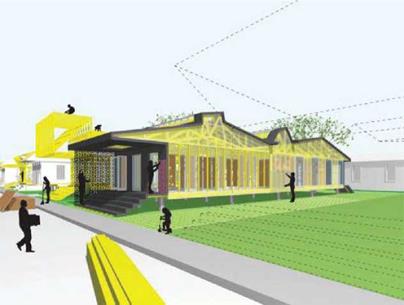What other things can we send the recipe for instead of the object?
One solution is in the advances made by rapid prototyping machines. We already have the ability to print books at the source, instead of at a central printing facility (think downloadable PDF and ink jet printer). Why not do the same with furniture, dishes, machine parts, and other products? Rapid prototyping processes (and the machines that employ them) already do this for some applications (such as prototypes). Currently, these machines are limited in what they can produce, and the cost of the finished object is much more expensive than other forms of production. However, as the price falls for both machines and materials, at some point these devices will be affordable for people to have in their homes (or at a local site).
Perhaps the best example of informa – tionalization is the biology of nature, in particular, DNA.
There are a few different rapid prototyping processes, each employing slightly different materials and methods. Some use a powdered plastic material, others a liquid. Some are capable of producing hard plastics, others soft (like rubber). Some can even produce objects in color. There was a time that having a laser printer at home, or a color printer, was too expensive for most people. There may be a time when, like color printers now, rapid prototyping machines will allow us to send just the instructions to produce a design, rather than the finished object itself. This will drastically reduce the transportation impact, and because these processes are usually very efficient, possibly the production impact as well for many product solutions. Designers continually need to stay abreast of new manufacturing processes in order to take advantage of advances that affect how and what they can realize. These technologies offer the potential to build things that cannot be built in other ways while also reducing their environmental and possibly even social impact.
Perhaps the best example of informational – ization is the biology of nature, in particular, DNA. Consider how efficient this material and process can be: one cell, carrying a nano – scopic bit of molecules, can be responsible (in the right environment) for creating an entire organism. Even a simple virus, carrying a bit of DNA code, can splice into the replication process to insert itself, be replicated, and slowly change an organism. As well as being an example of how nature has, once again, beat us to an efficient design strategy (see Biomimicry in Chapter 3), this example may provide a new kind of design process and solution.
Since the 1980s, science fiction writers and some designers have been hypothesizing that the design of complex objects, like cars and buildings, can be produced via DNA code. Imagine a small set of DNA code that, when inserted into a vat of biological material, will code-assemble a complete car—structure, electrical system, engine, body, interior, and all—simply by chemical instruction. Or consider nanotechnology and the billions of dollars
spent on research into nanoassemblers—sub – microscopic machines that can build products one molecule at a time. If these visions come true, the roles of designers and engineers will change radically into something more like chefs developing a recipe. In the process, the materials and energy required to produce such solutions may become efficient to the point where they begin to approach the efficiency of nature’s exhibits.
Imagine a small set of DNA code that, when inserted into a vat of biological material, will code-assemble a complete car—structure, electrical system, engine, body, interior, and all— simply by chemical instruction.
Architecture for Humanity
In 1999, Cameron Sinclair and Kate Stohr started an organization, Architecture for Humanity,[56] as a response to the housing needs of refugees in Kosovo. Dissatisfied with the mundane demands of his current architecture job, Cameron reasoned that his skills—and those of other architects— could have more impact helping those in real need. He recognized that while food, water, and medical needs were a primary focus, shelters for refugees were unnecessarily costly, ill-suited to the locations in which they were deployed, and too few to respond quickly for the amount of need. And this was a perpetual problem (see Figure 9.1).
Armed with this understanding and drive, the two quickly organized a small competition to design and engage architects. They rightly assumed that, if they had ideas for better (medium-term) transitional housing solutions,
Architecture for Humanity (continued)
and could engage others in the process, still better solutions could be created. This was the first stage of using the strategy of informationalization to better solve the temporary housing challenge (though the two would probably have never used this term).
|
FIGURE 9.1. http://www. flickr. com/photos/rosenfeldmedia/3264764739 Architecture for Humanity’s Open Architecture Network makes plans for all kinds of temporary and permanent structures available to everyone around the world. |
Architecture for Humanity (continued)
The response was overwhelming. Over 220 entries to the competition were submitted, from 30 different countries—all with only a minimum of awareness in the industry. People, of course, weren’t sending actual housing prototypes, merely renderings, descriptions, and specifications. Because the field of architecture has developed enough language and conventions for evaluations, Kate and Cameron—and the other judges they had assembled—could make a reasonable critique of the entries without having to build each one. Another key learning fact that emerged immediately was that there wasn’t a single, best solution. In fact, the solutions were surprisingly ingenious and suited to different uses— even more than Stohr and Cameron had envisioned at the start of the competition. What they had amassed was a catalog of many, outstanding solutions. The next question was “what to do with them?”
Architecture for Humanity (continued)
AFH quickly learned that the realities of the relief industry, which were scouting suitable locations, getting materials through customs, securing work permits and approvals, etc., were next to impossible. They were not going to be able to select one or even a few of the structural designs to be created in mass quantity, get materials where they were needed, or have housing built. They needed a different solution. So, the two did something different than standard operating procedures in the relief industries.
The competitions had been so successful, and had taught them the power of bringing multiple minds to bear to a challenge, so in 2007, they created the Open Architecture Network. Employing “Creative Commons” licensing, this allowed any designer or architect to upload any solution to the network, and it could be downloaded by anyone who needed it wherever they were. In effect, they created a recipe catalog
Architecture for Humanity (continued)
for relief housing accessible from anywhere with an Internet connection. The catalog is open so the recipes are ever-expanding, in order to meet the ever-expanding needs of refugee, relief, and temporary housing needs.
The end-solution requires some management and tools for sifting through the designs to find the best and most appropriate way to make the system more usable, but it is an extraordinary solution and one that thrives on the idea of informationalization.
We’ve all seen the surveys that rank lawyers and used car salesmen near the bottom of trusted job titles. In their defense, however, used car salesmen are providing a service that serves sustainability. It is almost always better to reuse products and components than to dispose of (or recycle) them in order to make room for new ones. This principle, of course, relies on the fact that the older products were well designed, met our needs, and were socially and environmentally acceptable.
Consider buildings, for example. Our desire to demolish older buildings in order to build bright, shiny new ones (that rate highly in LEED1 building standards) often creates an amount of wasted material and energy that the new buildings could never compensate for. Destroying all of the structure and material in a building, plus hauling away the remains, plus transporting the new materials to the site, plus the new construction takes a lot of material and energy. It’s often a more sustainable solution, providing that the building is sound, to retrofit existing buildings with new materials (only where necessary) and efficiency technologies. Likewise,
continuing to drive an older Honda is often better than scrapping it and driving a new hybrid.
Designers and engineers often dislike these solutions because they feel deprived of the ability to create something new. Plus, they fear that there won’t be a viable market for entirely new solutions if people reuse every piece of older ones. (Cuba and its reuse of classic cars is a notable exception.) There’s little chance that such a shift in society will take place quickly, so we’ll all still have jobs for the foreseeable future. However, if we care about sustainability, we have two new opportunities and responsibilities. The first opportunity is to retrofit existing structures and solutions whenever appropriate, which is in itself a design and engineering challenge. The second one is to rethink the reusability of everything we develop from now on.
Careful understanding of our customers contexts, needs, and desires, as well as ^ >
 an understanding of the ecosystems of materials, energy, and life cycles of the things they use, can lead us to better solutions for the new things
an understanding of the ecosystems of materials, energy, and life cycles of the things they use, can lead us to better solutions for the new things
FIGURE 10.1
/W http://www. flickr. com/photos/ rosenfeldmedia/3265592554
Artechnica’s tranSglass® vases reuse common wine bottles to uncommon effect. www. artechnicainc. com
we do bring into this world and what will happen to those things when they are no longer needed. Not only can reusability be designed into some products and services, but also the ease at which things can be reused is directly a function of how we design, engineer, and produce things.
We can’t anticipate all reuses of products, of course, nor should we try. For example, Artechnica takes wine bottles and transforms them into beautiful vases simply by cutting their tops off at an unusual angle and finishing the edges (see Figure 10.1). The designers of the original bottle could hardly anticipate this use of their product, yet the end result is still something beautiful—and more valuable—than the original empty bottle.
However, we can keep in mind the reuse of the things we design by understanding how they’re made and used, and how they can be valued when our customers are finished with them. One strategy is to extend their use in the first place, making them last longer. Another is to design their operation and components to be easily exchanged so that the majority of the components—and environmental impact—stay in use. By consciously making components easy and cost-effective to replace, many products can live on much longer than we would expect.
CHAPTER 10




